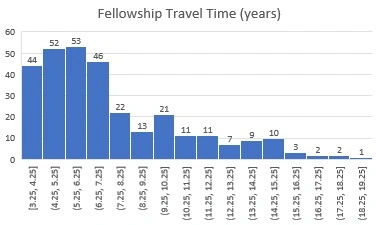
Time to qualify as an IFoA actuary: how long it really takes in practice
by Patrick Lee on 01 May 2023 in categories actuarial with tags ifoa lifelong learning maths#actuaries #traveltime #education #standards #ifoa
Methodology
I have carried out an analysis of what I hope is a representative sample from the 3,438 new qualifier records currently publicly available from the IFoA (Institute and Faculty of Actuaries) website. The latter are the new qualifiers from the 6 lists published from August 2020 to December 2022.
I have analysed 415 out of the 3,438 records.
The sample I have taken covers 108 out of the 584 new Associates and 307 out of the 2,618 new Fellows.
For each of these I have extracted (via a search on LinkedIn and/or the web generally) the likely starting date of work as an actuary (e.g. as an Actuarial Trainee, or Actuarial Assistant or similar). I have not taken the start date of an actuarial science degree or Masters, and I have ignored placements at actuarial firms during part of a degree course, and summer intern placements.
So for example, for someone doing a 3 year actuarial science degree followed by a one year Masters in Actuarial Science, I have taken the start date as the first date on their profile after the end of both of those.
I have then used the time between that start date and the start of the month of issue of the relevant IFoA new qualifiers list (e.g. 1 December 2022 for the December 2022 list). That is the travel time to Associate or Fellow, depending on which list the actuary appears in.
Important: because I am also interested in the time it takes to get from Associate to Fellow, I included in my sample of Associates and Fellows those who appeared as both of these in the 6 new qualifier lists. I will give the figures both including and excluding these "double" members in case that introduces a bias.
Headline results:
Associate Travel time: median 5.54 years, mean 6.71 years. Excluding double members: median 4.21, mean 6.18
Fellow Travel time: median 6.63 years, mean 7.42 years. Excluding double members: median 6.09, mean 7.23.
A fuller article coming later with results split by sex, country, whether or not the student did an actuarial science course, and university.